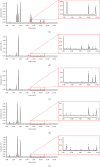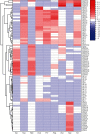Study on Closely Related Citrus CMMs based on Chemometrics and Prediction of Components-Targets-Diseases Network by Ingenuity Pathway Analysis
- PMID: 35529921
- PMCID: PMC9068285
- DOI: 10.1155/2022/1106353
Study on Closely Related Citrus CMMs based on Chemometrics and Prediction of Components-Targets-Diseases Network by Ingenuity Pathway Analysis
Abstract
As the representatives of closely related Chinese medicinal materials (CMMs) originated from Rutaceae family, Aurantii fructus immaturus (AFI), Aurantii fructus (AF), Citri reticulatae pericarpium viride (CRPV), and Citri reticulatae pericarpium (CRP) have better functions in regulating qi and promoting gastrointestinal motility. However, differences in the quality of closely related Citrus CMMs have not yet been revealed until now. Herein, this study focused on the systematic differentiation and in-depth understanding of closely related Citrus CMMs by a strategy integrating chemometrics and network pharmacology. Determined by ultra performance liquid chromatography, the content of nine flavonoids showed obvious fluctuations in the decoction pieces from different species (Citrus aurantium Linnaeus and Citrus reticulate Blanco) with decreasing levels in the samples of ripe fruits. Decoction pieces from the different species and ripening stages were well distinguished by orthogonal projection to latent structure-discriminate analysis (OPLS-DA) and cluster analysis. As a result, four active components including narirutin, naringenin, hesperidin, and 3,5,6,7,8,3',4'-heptemthoxyflavone were filtered out by variable importance for the projection (VIP) value (VIP > 1.0), which were regarded as chemotaxonomic markers. Furthermore, a components-targets-diseases network was constructed via ingenuity pathway analysis (IPA), and the correlations were predicted between four chemotaxonomic markers, 223 targets, and three diseases including colitis, breast cancer, and colorectal cancer. The obtained results will be of great significance for identifying closely related Citrus CMMs and conduce to improving the resource utilization of CMMs.
Copyright © 2022 Qixuan Mu et al.
Conflict of interest statement
The authors declare that they have no conflicts of interest.
Figures






References
-
- Editorial Board of Chinese Pharmacopoeia. Pharmacopoeia of the People’s Republic of China . Beijing, China: Chemistry and Industry Press; 2020.
-
- Tong R., Peng M., Tong C., Guo K., Shi S. Online extraction-high performance liquid chromatography-diode array detector-quadrupole time-of-flight tandem mass spectrometry for rapid flavonoid profiling of Fructus Aurantii Immaturus. Journal of Chromatography B, Analytical Technologies in the Biomedical and Life Sciences . 2018;1077-1078:1–6. doi: 10.1016/j.jchromb.2018.01.031. - DOI - PubMed
-
- He X., Huang S., Wu M., et al. Simultaneous quantitative analysis of ten bioactive flavonoids in Citri Reticulatae Pericarpium Viride (Qing Pi) by ultrahigh‐performance liquid chromatography and high‐resolution mass spectrometry combined with chemometric methods. Phytochemical Analysis . 2021;32(6):1152–1161. doi: 10.1002/pca.3056. - DOI - PubMed
LinkOut - more resources
Full Text Sources
Research Materials
Miscellaneous

